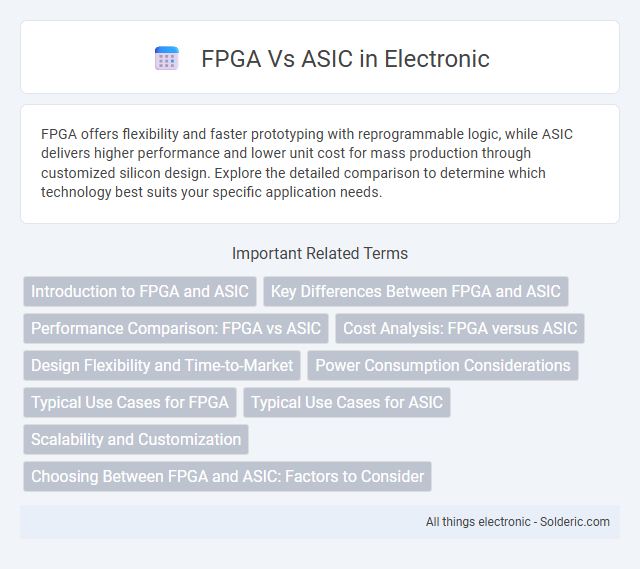FPGA offers flexibility and faster prototyping with reprogrammable logic, while ASIC delivers higher performance and lower unit cost for mass production through customized silicon design. Explore the detailed comparison to determine which technology best suits your specific application needs.
Comparison Table
| Feature | FPGA (Field Programmable Gate Array) | ASIC (Application-Specific Integrated Circuit) |
|---|---|---|
| Design Flexibility | High - Reprogrammable | Low - Fixed functionality |
| Development Cost | Low - No mask costs | High - Expensive mask and fabrication |
| Production Volume | Best for low to medium volume | Optimized for high volume manufacturing |
| Performance | Moderate - Lower clock speeds | High - Optimized for speed and efficiency |
| Power Consumption | Higher power consumption | Lower power consumption |
| Time to Market | Short - Quick prototyping | Long - Complex design and fabrication |
| Unit Cost | Higher per unit cost | Lower per unit cost at scale |
| Use Cases | Prototyping, low-volume products, flexible applications | Mass production, high-performance custom devices |
Introduction to FPGA and ASIC
FPGA (Field-Programmable Gate Array) is a reconfigurable integrated circuit allowing hardware designers to program custom digital logic after manufacturing, enabling flexibility and rapid prototyping. ASIC (Application-Specific Integrated Circuit) is a fixed-function chip designed for a particular application, offering higher performance and lower power consumption but with higher initial development costs. Understanding the distinction between FPGA and ASIC helps you choose the ideal solution based on factors like design complexity, production volume, and time-to-market requirements.
Key Differences Between FPGA and ASIC
FPGA (Field-Programmable Gate Array) offers reconfigurability and rapid prototyping, enabling designers to modify hardware post-manufacturing, while ASIC (Application-Specific Integrated Circuit) delivers higher performance and lower unit cost in large production volumes due to its fixed architecture. FPGA designs typically have longer signal propagation delays and consume more power compared to ASICs optimized for specific tasks. Cost considerations show FPGAs are cost-effective for low to medium volume applications, whereas ASICs become economical only at high volume production due to their expensive non-recurring engineering (NRE) costs.
Performance Comparison: FPGA vs ASIC
ASICs deliver superior performance compared to FPGAs due to their custom-designed hardware optimized for specific tasks, resulting in higher clock speeds and lower latency. FPGAs offer flexibility and rapid prototyping advantages but generally exhibit slower processing speeds and increased power consumption relative to ASICs. For high-performance applications requiring maximum efficiency and speed, ASICs remain the preferred choice.
Cost Analysis: FPGA versus ASIC
FPGA offers lower initial costs due to its reprogrammable nature, making it ideal for prototyping and low-volume production runs. ASIC development requires significant upfront investment in design and manufacturing, but benefits from lower unit costs at high volumes due to optimized performance and efficiency. Your decision between FPGA and ASIC should consider both project scale and budget to optimize cost-effectiveness.
Design Flexibility and Time-to-Market
FPGA offers unparalleled design flexibility due to its reprogrammable logic blocks, enabling rapid prototyping and iterative development without the need for new hardware. ASICs provide fixed-function designs tailored for high performance and energy efficiency but require significantly longer development cycles and higher initial costs. Time-to-market for FPGA-based solutions is substantially shorter, making them ideal for evolving applications and early-stage product validation.
Power Consumption Considerations
FPGA devices typically consume more power than ASICs due to their general-purpose architecture and programmable logic elements, which lead to less efficient signal routing and higher static power dissipation. ASICs enable lower power consumption by implementing custom-designed circuits optimized for specific applications, reducing switching activity and leakage currents. Understanding these power consumption considerations is crucial when choosing the right technology for your energy-sensitive projects.
Typical Use Cases for FPGA
FPGAs are commonly used in prototyping, telecommunications, aerospace, and defense applications due to their reconfigurability and rapid development cycles. They excel in custom digital signal processing, hardware acceleration, and real-time data processing in industries requiring flexibility and iterative testing. FPGAs enable cost-effective deployment for low to medium volume production where design changes are frequent or time-to-market is critical.
Typical Use Cases for ASIC
ASICs are predominantly used in high-volume, performance-critical applications like smartphones, data centers, and automotive systems due to their superior speed, power efficiency, and customizability. They excel in tasks requiring optimized hardware for specific algorithms, such as cryptographic processing, AI inference, and signal processing. Industries favor ASICs for cost-effective mass production with tailored functionalities that outperform general-purpose alternatives like FPGAs.
Scalability and Customization
FPGAs offer exceptional scalability and customization by allowing designers to reprogram hardware configurations multiple times, adapting quickly to evolving requirements and enabling rapid prototyping. In contrast, ASICs provide superior customization for high-volume production with optimized performance and power efficiency tailored specifically to your application, but lack flexibility once fabricated. Choosing between FPGA and ASIC depends on the balance between the need for scalable adaptability and highly specialized, fixed-function designs.
Choosing Between FPGA and ASIC: Factors to Consider
Choosing between FPGA and ASIC involves evaluating factors such as development cost, time-to-market, and production volume. FPGAs offer flexibility and rapid prototyping with lower initial costs, making them ideal for small batches or evolving designs, while ASICs provide optimized performance, power efficiency, and lower per-unit costs at high volumes. Design complexity, customization needs, and lifecycle requirements also influence the decision, with ASICs suited for long-term, high-performance applications and FPGAs favored for adaptability and shorter development cycles.
FPGA vs ASIC Infographic

 solderic.com
solderic.com